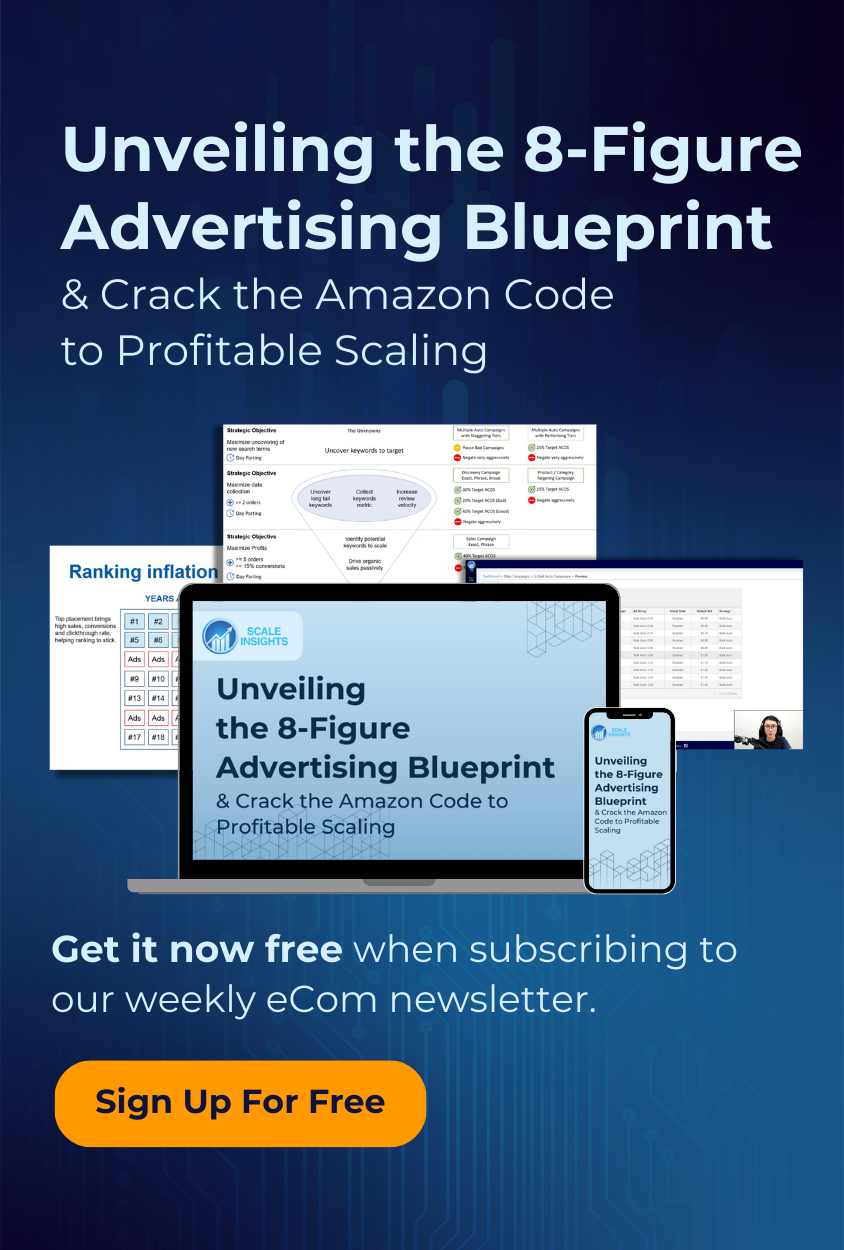Amazon ACOS stands for "Advertising Cost of Sales" and is a metric used in Amazon PPC campaigns to measure the effectiveness and profitability of advertising spend.
It is expressed as a percentage and represents the amount spent on advertising compared to the revenue generated from those advertising efforts. A lower ACOS indicates a more profitable campaign, while a higher ACOS means the campaign is less profitable. Understanding and optimising ACOS is critical to the success of an Amazon PPC campaign.
1. Understanding ACOS
Understanding ACOS is crucial for Amazon sellers because it is a key metric used to measure the effectiveness of their advertising campaigns. ACOS, or Advertising Cost of Sales, represents the percentage of sales revenue a seller spends on advertising. By monitoring ACOS, sellers can determine if their campaigns are profitable or need to adjust their PPC strategies to improve their ROI.
Additionally, ACOS helps sellers decide their advertising budgets and which campaigns to prioritise. A thorough understanding of ACOS can help sellers optimise their Amazon PPC campaigns and increase profitability.
2. What Is Amazon ACOS?
ACOS represents the percentage of sales revenue that is spent on advertising.
The Amazon ACOS formula is as follows:
ACOS = (Advertising Cost ÷ Total Ad Sales) x 100%
For example, if a seller spends $100 on advertising and generates $1,000 in sales, the ACOS would be 10%:
ACOS = ($100 ÷ $1,000) x 100% = 10%
In this case, the seller spent 10% of their sales revenue on advertising.
Understanding Amazon's ACOS Across Different Levels
ACOS can be calculated and can be analyzed across four different levels: Ad Group Level, Campaign Level, Keyword Level, and Account Level. Each level provides unique insights and is essential for optimizing and refining your advertising strategy on Amazon.
Ad Group Level
At the Ad Group Level, ACOS is calculated for a collection of similar products. This granular view allows sellers to determine which specific group of products is performing well and which isn't. Here's why this is important:
Product Performance Insight: By analyzing ACOS at the ad group level, sellers can identify which products within the group drive performance and which may be weighing it down.
Targeted Adjustments: If a particular ad group has a high ACOS, sellers can adjust the products, such as changing bids or optimizing listings, to improve the group's overall performance.
Campaign Level
Moving a step higher, ACOS is also calculated at the Campaign Level. This covers all ad groups within a particular campaign. The campaign-level ACOS is critical for several reasons:
Budget Allocation: It helps sellers see the bigger picture of how their budget is being utilized and which campaigns are delivering the best return on ad spend.
Strategic Decisions: Sellers can increase the budget on campaigns with a low ACOS or restructure those with a high ACOS.
Overall Performance Tracking: Campaign-level ACOS allows sellers to track the performance of their advertising strategies over time, adjusting for seasonality, promotions, and other factors.
Keyword Level
Drilling down to the Keyword Level, ACOS is measured for each specific keyword within a campaign. This level is particularly insightful for optimization:
Keyword Optimization: Sellers can identify which keywords are most effective at driving sales and which cost money without sufficient return.
Search Term Value: By understanding which keywords have a lower ACOS, sellers can infer the value of certain search terms and the customer intent behind them.
Bid Management: Sellers can adjust bids on individual keywords based on their ACOS, allocating more budget to profitable keywords and reducing spend on underperforming ones.
Account Level
Finally, at the Account Level, ACOS is aggregated across all campaigns. This high-level perspective is essential for business-wide decision-making:
Performance Overview: It provides a snapshot of the overall efficiency of the Amazon PPC strategy across the entire account.
Strategic Planning: Sellers can use account-level ACOS to make informed decisions about their overall sales strategy on Amazon, including how much of their total sales should come from advertising.
Resource Allocation: By understanding the account-level ACOS, sellers can determine if they need to invest more resources into PPC management or if their advertising efforts are on the right track.
3. Difference Between ACOS And ROAS
ACOS and ROAS are critical metrics for gauging the effectiveness of Amazon PPC campaigns, but they highlight different aspects of your advertising performance.
ACOS is the percentage of direct sales you've made from a particular ad compared to how much you've spent on that ad. It's calculated by dividing the total ad spend by the total ad sales generated from the ads. A lower ACOS implies you're spending less to make a sale, which is generally more favorable.
On the other hand, ROAS represents how much revenue you're generating for every dollar spent on advertising. It's determined by dividing the revenue generated from the ads by the total ad spend. A higher ROAS is better, indicating that you're generating more sales for each dollar spent on advertising.
While both are important, they offer different perspectives: ACOS looks at the cost-effectiveness of the ad relative to sales, while ROAS measures the gross revenue yield from each dollar spent on advertising. Both need to be assessed to fully understand the performance of your Amazon PPC campaigns.
4. What Is A Good ACOS For Amazon PPC
Defining What A Good ACOS Is
A "good" ACOS is subjective and can vary significantly depending on various factors such as your industry, product margins, and overall business goals.
However, a general benchmark for a good ACOS is one that falls below your profit margin percentage. This means that your advertising campaigns are profitable and contributing positively to your bottom line.
For instance, if you have a profit margin of 30% on a product, an ACOS below 30% means you're making a profit on each sale generated by your PPC campaigns. Conversely, an ACOS above 30% would indicate that you're losing money on those sales.
Typically, sellers might aim for an ACOS between 15% to 25%. A lower ACOS often indicates efficient ad spend, whereas a higher ACOS may suggest that your ads are not as effective or that your product margins are too tight to support such levels of advertising spend.
Break-Even ACOS
The break-even ACOS is the point where your advertising cost is exactly equal to your profit margin. At this point, you're not making a profit, but you're not incurring a loss on your PPC campaigns either.
It is an essential benchmark for sellers because it sets the upper limit of what you can afford to spend on ads for your product without losing money.
Calculating your break-even ACOS is straightforward. If your profit margin is 30%, your break-even ACOS is also 30%. Any ACOS above this percentage means you're losing money on your ad spend, while any ACOS below it means you're making a profit.
Consider This Example When Determining What A Good ACOS Is For Your Amazon PPC Campaigns
Emma sells eco-friendly utensils on Amazon. Her product line is well-received due to the growing trend in sustainable products. Let's go through her costs and sales to understand her break-even ACOS.
Cost of Goods Sold (COGS): Emma's COGS for a set of eco-friendly utensils is $15.
Selling Price: She sells a set for $50 on Amazon.
Profit Margin: Her profit before ad spend is $50 - $15 = $35 per set.
Profit Margin Percentage: This is ($35 profit / $50 selling price) * 100 = 70%.
Now, Emma has decided to run a PPC campaign to increase her sales. Here's the outcome:
Ad Spend: She spends $10 on ads for a particular set of utensils.
Sales Generated: This ad spend results in sales of $50 from the campaign.
To calculate the ACOS:
ACOS: (Ad Spend / Sales Generated) * 100 = ($10 / $50) * 100 = 20%.
Emma's ACOS is 20%, which is well below her profit margin of 70%. This means she is making a profit from her PPC campaigns. But what is her break-even ACOS?
Calculating Break-Even ACOS
To find the break-even ACOS, we look at Emma's profit margin. Since her profit margin is 70%, her break-even ACOS would be the same, assuming all other costs are included in the COGS, and there are no additional operational expenses considered.
Here's why:
Break-Even Point: At break-even, the cost of ads equals the profit margin. So if Emma's profit margin is $35 (which is 70% of her selling price), her ad spend at break-even would also be $35.
Break-Even ACOS Calculation: (Break-Even Ad Spend / Sales Generated) * 100 = ($35 / $50) * 100 = 70%.
Therefore, if Emma has an ACOS of 70%, she is neither making a profit nor a loss on her PPC campaign. If her ACOS goes above 70%, she would start losing money on her ads, and if it stays below 70%, she is making a profit.
In this scenario, with a current ACOS of 20%, Emma's campaign is highly profitable, as it is significantly below her break-even ACOS of 70%.
This indicates that for every dollar she spends on ads, she retains a substantial portion of her profit margin, which is a strong position for her business.
Therefore, it's crucial to evaluate ACOS in conjunction with other metrics and adjust strategies accordingly.
5. How ACOS Impacts Amazon Sellers
ACOS (Advertising Cost of Sales) is an important metric for Amazon sellers because it directly impacts their profit margins. A high ACOS means that advertising costs are eating into their sales revenue, reducing their profitability. On the other hand, a low ACOS indicates that advertising is efficient and effective in generating sales.
By understanding their ACOS, sellers can make informed decisions about their advertising budgets and strategies to maximise their return on investment (ROI). Overall, ACOS is a crucial metric for Amazon sellers to monitor and optimise to ensure their advertising efforts deliver the desired results.
Measuring Profitability
ACOS plays a critical role in measuring the profitability of Amazon sellers, especially for those who rely on Amazon PPC campaigns to drive sales. By calculating ACOS, sellers can determine the effectiveness of their advertising campaigns and adjust their strategies to maximise profitability.
ACOS and PPC campaigns are closely related because ACOS measures the direct impact of advertising spending on sales revenue. When sellers run PPC campaigns, they set a maximum bid for each keyword and pay a fee each time a customer clicks on their ad. This advertising spend contributes to the total cost of sales, which is used to calculate ACOS.
By tracking ACOS over time, sellers can determine the optimal bid for each keyword and adjust their advertising spend accordingly. For example, if a keyword has a high ACOS, sellers may need to lower their bid or revise their ad targeting to reduce costs and improve profitability.
On the other hand, if a keyword has a low ACOS, sellers may want to increase their bid to maximise exposure and drive more sales.
6. Amazon ACOS Strategies To Improve Your Campaigns
Strategies to improve Amazon ACOS involve implementing best practices and tips for optimising PPC campaigns, improving product listings, and reducing wasteful spending. Here are some strategies:
Targeting The Right Keywords
Keywords are the cornerstone of your Amazon PPC campaigns. They trigger your ads to appear in search results and on product detail pages. To improve your ACOS:
-
Start with comprehensive keyword research.
-
Look for high-intent keywords that are most relevant to your product.
-
Utilize tools like Amazon's own keyword planner or third-party software to uncover hidden gems that have high search volume but lower competition.
Once you have a robust list, structure your campaigns to differentiate between broad, phrase, and exact match types.
This will help you capture a wide audience while also targeting specific customers. Use exact match for keywords that are highly relevant and convert well, as this will likely lead to a better ACOS.
Meanwhile, broad and phrase match types can be used for discovering new, relevant keywords that have the potential to convert.
Optimising Product Listings
Your product listings play a significant role in your ACOS. They need to be optimized not just for visibility but also for conversion.
Ensure your listings have high-quality images, detailed and keyword-rich descriptions, and clear feature bullets. The more relevant your listing is to the customer's search query, the higher the likelihood of conversion.
Moreover, the conversion rate directly impacts your ACOS. If your listing is well-optimized and converts at a higher rate, you can achieve more sales with less ad spend, reducing your ACOS. Remember that Amazon also determines listing quality when determining how often your ads are shown.
Refining Targeting Options
Amazon offers various targeting options that can help you refine who sees your ads. Use these options to your advantage by targeting specific customer segments.
For instance, product targeting allows you to place your ads on the pages of related products or competitors' products. This can be a powerful way to introduce your product to buyers interested in similar items.
In addition, consider utilizing Amazon's audience targeting features such as interests, lifestyles, and shopping behaviors. Aligning your targeting with the customer's place in the buying cycle allows you to tailor your approach to various segments, potentially improving your ACOS.
Adjusting Bids
Bid management is crucial for maintaining a healthy ACOS. You should regularly review your campaigns to adjust bids based on performance.
If a keyword converts well and profitably, you may want to increase the bid to capture more volume. Conversely, decrease the bids on keywords that are costing too much compared to the sales they bring in.
Use Scale Insights’ dynamic bidding adjustment feature. Preset bidding rules will respond to changes to your ACOS by reducing the keyword bid. Dynamic bidding considers historical keyword performance and adjusts your bids accordingly to reach the target ACOS.
Monitoring Negative Keywords
Negative keywords are as important as your target keywords. They prevent your ads from appearing on irrelevant search queries, which can drain your ad budget without bringing in sales. Regularly monitor your search term reports to identify irrelevant or underperforming search terms.
Adding these as negative keywords will help refine your campaign and improve ACOS by reducing wasted spend.
Testing Ad Types And Formats
Amazon offers a variety of ad formats, including Sponsored Products, Sponsored Brands, and Sponsored Display.
Each ad type has strengths and can be optimized for different goals and target audiences. Continuously test different ad formats and types to see which ones yield the best results for your products and objectives.
For instance, Sponsored Products are great for driving sales for a specific item. At the same time, Sponsored Brands can help increase brand awareness.
Sponsored Display Ads, however, can retarget customers who have viewed your products but haven't purchased them. By analyzing the performance data, you can allocate more budget to the ad types that contribute to a lower ACOS.
Monitoring and adjusting campaigns regularly is essential for Amazon sellers who want to improve their ACOS. Regular monitoring of campaigns allows sellers to see opportunities to optimise their ads and reduce their ACOS.
Additionally, adjusting campaigns based on performance data can help sellers identify which keywords, ad groups, and campaigns generate the best results and allocate their ad spend accordingly. By making these adjustments, sellers can improve their ACOS and maximise their profitability on the Amazon platform.
Want to learn more about Amazon PPC? Explore these informative articles: How Much is Amazon PPC, Best Amazon Analytics Tools, and Advanced PPC Strategies.
7. Factors That Influence a Good ACOS
ACOS represents the ratio of ad spend to targeted sales and is a clear indicator of the efficiency and effectiveness of Amazon advertising campaigns.
However, determining what constitutes a 'good' ACOS can be as complex as the marketplace. It is influenced by many factors that can shift the goalposts for success.
A good ACOS is not a one-size-fits-all number; it varies widely based on individual business goals, product specifics, and market dynamics.
Product Life Cycle
The stage of your product in its life cycle plays a significant role in what a good ACOS might be. During the introduction phase, you might be willing to accept a higher ACOS as you're investing in gaining visibility and traction for your new product. Your main goal is to generate initial sales, gather reviews, and improve your organic ranking.
As the product moves into the growth and maturity stages, the ACOS should ideally decrease, reflecting the increased organic sales and stronger product recognition.
When a product reaches the decline stage, the ACOS could be lower. But, at this point, it's essential to assess if continued ad spend is justifiable or if resources should be allocated to newer, more profitable products.
Competition
The level of competition within your product category can significantly impact your ACOS. In a highly competitive market, you may need to bid higher for keywords to ensure your product is seen, which can lead to a higher ACOS.
Conversely, in a niche with less competition, your advertising dollars might yield a lower ACOS due to lower bid requirements and less pressure to outspend competitors.
Profit Margins
Profit margins are the backbone of determining a good ACOS. If your product has a high-profit margin, you have more leeway to spend on advertising, potentially accepting a higher ACOS while maintaining profitability.
On the other hand, products with thin margins require a much tighter control over ACOS to ensure that advertising costs don't eat into profits. Knowing your numbers is crucial; you should calculate the maximum ACOS you can afford while making a profit and use that as a campaign benchmark.
Brand Awareness Goals
Your strategic goals play a pivotal role in defining a good ACOS. If the objective is to increase brand awareness, you might be willing to invest in a higher ACOS.
Brand-building campaigns often don't yield immediate sales. However, they are designed to introduce your brand to a wider audience, with the expectation that this will increase sales over time.
For established products or brands, where the emphasis is on maintaining market share rather than expanding it, a lower ACOS might be the target, as it emphasizes profitability over visibility.
Seasonality
Seasonality can dramatically affect ACOS due to fluctuations in consumer behavior throughout the year. During peak shopping times like the holiday season, you might experience a lower ACOS due to a higher volume of organic sales.
Conversely, during off-peak times, you may see a higher ACOS as you work harder to capture consumer attention.
8. Common Mistakes To Avoid
-
Setting a low ACOS target without considering the product's profitability: While having a low ACOS is desirable, it should not come at the expense of profitability. A low ACOS target may result in lower sales and decreased profitability.
-
Not monitoring campaigns regularly: Failing to monitor campaigns regularly can result in wasted ad spend and higher ACOS. Reviewing campaigns regularly and adjusting bids, keywords, and targeting to PPC Optimization performance is important.
-
Not optimising product listings: Product listings play a crucial role in determining the success of PPC campaigns. Failing to optimise product listings can result in lower conversion rates, higher bounce rates, and higher ACOS.
-
Targeting the wrong keywords: Targeting the wrong keywords can result in wasted ad spend and higher ACOS. It's important to research and target keywords relevant to the product and with a high search volume.
-
Ignoring negative keywords: Negative keywords are search terms irrelevant to the product and can result in wasted ad spend. Identifying and adding negative keywords to campaigns is important to avoid irrelevant clicks and lower ACOS.
9. Tools And Resources For Managing Amazon ACOS
There are several tools and resources available to help Amazon sellers manage their ACOS effectively:
-
Amazon Advertising Console: Amazon provides its own advertising console that allows sellers to create and manage their PPC campaigns, including tracking their ACOS.
-
Third-party PPC management tools: Several third-party tools are available that help sellers optimise their PPC campaigns and monitor their ACOS.
-
Google Analytics: While Google Analytics is not specific to Amazon, it can be used to track the performance of Amazon PPC campaigns and calculate ACOS.
-
Amazon ACOS calculators: Various free online calculators are available that help sellers calculate their ACOS and determine if their campaigns are profitable.
-
Amazon seller forums and communities: Online forums and communities for Amazon sellers can be a great resource for advice and tips on managing ACOS effectively.
Conclusion On Amazon ACOS
Understanding and regularly monitoring Amazon ACOS is crucial for the success of any Amazon seller. ACOS can help measure profitability and gauge the effectiveness of PPC campaigns. By following best practices and tips for improving ACOS, such as optimising keywords and bids, sellers can boost their profits and drive their business forward.
Lower your ACOS with Scale Insights, the cutting-edge, AI-powered Amazon analytics tool designed to supercharge your advertising campaigns and maximize profitability.
Explore Amazon PPC Tools with these articles: Amazon Seller Analytics Software, Best Amazon Analytics Tools, and Amazon PPC Automation Software. Enhance your advertising strategy today!
Experience the power of data-driven insights and optimization. Try a free 30-day trial (no credit card needed), starting at $78 up to $688 monthly. Customized plans are available for up to 2,000 automated ASINs.
Frequently Asked Questions About Amazon ACOS
How Does ACOS Impact Amazon Sellers?
ACOS impacts Amazon sellers because it directly affects the profitability of their PPC campaigns. The higher the ACOS, the lower the profit margin.
What Is The Difference Between ACOS And ROAS?
The difference between ACOS (Advertising Cost of Sales) and ROAS (Return on Ad Spend) lies in their calculations and focus. ACOS represents the percentage of ad spend relative to sales generated, whereas ROAS measures the revenue generated per dollar spent on advertising, essentially the inverse of ACOS.
How Does Product Selection Affect My Amazon ACOS?
Product selection can significantly affect your Amazon ACoS, as some products may have higher demand, lower competition, or better profit margins. By focusing on high-performing products with strong conversion rates, you can potentially achieve a lower ACoS and maximize your advertising efficiency.
Can I Improve My Amazon ACOS By Optimizing Product Listings?
Yes. Enhancing your product titles, descriptions, and images, and using high-search volume, but low-competition keywords can result in higher CTRs (Click-Through-Rates), and conversion rates, ultimately leading to a more efficient ACOS.
What Is The Best ACoS On Amazon?
The "best" ACoS on Amazon varies by product, category, and business goals, but typically, an ACoS lower than your profit margin percentage is considered good, as it indicates you are earning more than you're spending on ads.
Is 100% ACoS Acceptable?
An ACoS of 100% means you're breaking even on your ad spend relative to direct sales; it may be acceptable if the strategy is to gain exposure or drive initial sales for a new product, but it's not sustainable for profitability in the long term.
Is A Low ACoS Good?
A low ACoS indicates that you're spending a small amount on advertising relative to your revenue, which is generally good for profitability; however, it's important to balance it with growth goals, as too low ACoS could mean missed opportunities for expansion.
What If The ACoS Is High?
If the ACoS is high, it suggests you're spending too much on ads compared to the revenue those ads generate. It's a signal to review and optimise your campaigns, either by improving your ad targeting, adjusting bid prices, or refining your ad content.



 Scale Insights Team
Scale Insights Team


